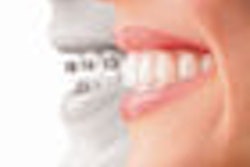
Align Technology has come under fire since announcing that, starting June 1, all dentists who want to be "active Invisalign providers" must start at least 10 Invisalign cases and complete at least 10 Invisalign continuing education courses annually.
But the company is defending its new "proficiency program," saying the change is necessary to maintain the integrity of the Invisalign brand and ensure that patients receive the best treatment possible.
“We're committed to educating consumers about what it means to be an Invisalign provider.”
— Dan Ellis, vice president of
North American sales for
Align Technology
"As awareness and acceptance of Invisalign has grown, so has consumer demand and the size of our trained doctor base," the company stated in a letter it sent to its 40,000-plus Invisalign-trained doctors announcing the new program. "Attaching proficiency requirements to using Invisalign helps Align preserve the integrity of the Invisalign brand for prospective patients and for the doctors who use our products."
Since introducing Invisalign 10 years ago, Align has only required its customers to take a single certification course to be able to refer to themselves as active Invisalign providers -- even if they never performed a single case afterward, according to Dan Ellis, vice president of North American sales.
"We've known for years that we have thousands of certified doctors who are not doing enough volume to keep up with an evolving, skill-based procedure," Ellis said. "But we have never been in a position where we differentiated between someone who has a lifetime skill of one case versus someone who has done 1,000 cases."
Align spends millions of dollars each year on marketing that drives consumers to dental offices in search of Invisalign, "and we feel a responsibility to those consumers," he noted. "So we believe this is the right and responsible thing to do."
A look at various online forums, however, indicates that some dental practitioners feel the company's new policy stems more from a desire to increase sales and revenues than to protect consumers (Align's stock price has actually fallen more than three points since announcing the program, from 12.71 on June 2 to 9.49 on June 22). Some note that the program is a further burden at a time when case acceptance is already down because of the economy, and others say they are now considering competing products.
"A lot of talented, innovative doctors make up Align's roots and are directly responsible for the company's growth and success over the years," noted one dentist in the DrBicuspid.com General Dentistry Forum. "The implementation of this program in its current form comes as a real slap in the face to many of us [general practitioners] and will certainly change a lot of opinions."
Some have also raised questions about what appears to be an attempt to dictate clinical practice. But that is not the case, according to Ellis.
"By no stretch of the imagination are we trying to develop or level clinical standards," he said. "We are strictly talking about our product. It is not our business or place to institute clinical standards or competencies for orthodontists or anyone else. But we do have a responsibility and right to ensure that our product is handled the best way it can be."
ADA and AGD statements
Many practitioners have taken their concerns to the ADA and the Academy of General Dentistry (AGD), prompting both organizations to issue statements. On June 12, the ADA put out a fact sheet that reads, in part:
As a general matter, manufacturers in the United States are free to impose minimum purchase and training requirements for their products and related services. The right to freely contract generally permits a company to set participation terms. It's up to the dentist to decide whether or not the terms are acceptable based on his or her practice. Questions concerning contract matters and other specific potential legal issues between a dentist and Align Technology would need to be analyzed with the dentist's personal attorney.
The AGD issued a news alert to its members that specifically addresses the new annual case-start requirement. "The number of patient cases started each year may not fully be within the dentist's control ... especially in the current economy," stated Vincent Mayher Jr., D.M.D., M.A.G.D., the immediate past president of the AGD, in the alert.
However, despite what Ellis calls "the economic holocaust of the past year" and the negative effects it has had on elective dentistry, he maintains that consumer interest in Invisalign is still strong.
"Consumer interest in Invisalign, as measured by hits to our Web site and other tools, has not declined in the least," said Ellis, noting that some 200,000 potential patients visit the company's Web site each month. "Granted, people would not be as willing to write a check for $5,000 to $6,000 today as they were a year ago, but they are willing to finance this, and we are working to educate our doctors about this. If consumer interest were 50% of what it was a year ago, we would have made a different decision."
In addition, contrary to concerns that additional costs would be associated with the new continuing education (CE) requirements, "there are over 200 credits of Invisalign-specific CE available on our Web site for free," Ellis said.
And not everyone thinks the proficiency requirements are a bad idea, he added.
"As we are tracking the positive and negative feedback on this, we are not surprised that a good part of the negative is from doctors who have done only one or two cases," he said. "They like promoting Invisalign in their practice because of the consumer appeal. [But] many doctors see the proficiency initiative as an opportunity to demonstrate their commitment to success with Invisalign, and Align wants to support that through our outreach to consumers. We're committed to educating consumers about what it means to be an Invisalign provider."
Copyright © 2009 DrBicuspid.com



















